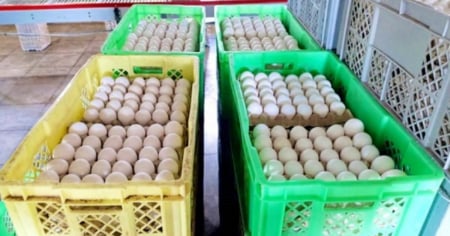The economic crisis in Cuba remains a topic of debate on social media, especially when it comes to the cost of food and the purchasing power with foreign currency.
In this context, a Cuban on TikTok decided to share her experience in a micro, small, and medium-sized enterprise (mipyme), showcasing the products she was able to purchase with 100 dollars.
In the video, which quickly went viral, the woman showcases a variety of products and comments that, despite the high prices, she managed to obtain a considerable amount of items.
"I am going to tell you the amount of food I am going to buy with this 100 dollars. This is to show you that when you budget well, things flow," she says before showing the shopping done.
The purchase included: a boneless loin for 11,000 Cuban pesos, a carton of eggs for 2,700 pesos, an 11-pound package of chicken for 3,600 pesos, one pound of cheese and snack spread for 700 and 600 pesos, respectively, 5 pounds of chicken gizzards for 2,300 pesos, 5 pounds of ground chicken for 1,515 pesos, two packages of croquettes at 100 pesos each, and a package of pre-fried potatoes for 3,500 pesos. Additionally, the purchase was supplemented with two bags of bread, a package of cookies, and five bags of rice.
However, the post has sparked wide debate on social media, where users have shared their own experiences and opinions on the cost of living on the island.
"I was sending 350 euros every month, and my sister told me it wasn't enough and that I needed to send more. I earn 1,600€ and my rent is 750€. So now I don't send anything, and I save myself from problems," commented a user, reflecting the pressure that some migrants feel to financially support their families in Cuba.
Another internet user expressed their surprise at the video: “I'm going to save this video because, according to my family, you can’t buy anything with 100 dollars. So I see this and I didn't understand anything.”
But there were also those who pointed out that the cost of products varies depending on the province and the availability of certain foods. “That also depends on where you live, because I'm from Sancti Spíritus and I spent three days in Cuba. Believe me, that pork loin is not available, and rice is at 230 per pound… the math doesn't add up. And I don’t feel cheated because prices are through the roof,” a user recounted.
Some pointed out that, although the purchase shown in the video is substantial, it is not enough to feed a family for an extended period. “100 dollars lasts a week, to buy food, pay for electricity, oil, seasonings, salad, hygiene products, and so on... Here, prices are sky-high and no one wants to cheat anyone, especially not a relative who cares for their loved ones,” commented another person.
The discussion also revolved around the role of remittances and the responsibilities of relatives on the island. “It’s about helping, not providing 100%. They can also work to afford the rest, right? Or is it about sending money so that no one works or what?” questioned a user.
This type of video has become common on social media, as evidenced by a similar case where a couple showed how much they could buy with 100 dollars in the Cuban market.
In that video, which dates back to 2023, the couple managed to acquire 12 pounds of pork, 8 pounds of lamb, an avocado, a package of sausages, and other staple products, but they highlighted that the purchase would only last a little over a week.
These examples reflect the severe inflation crisis that Cuba is experiencing. According to recent data, inflation in the formal market has exceeded 30% in the past year, primarily affecting food and transportation.
This is compounded by the devaluation of the Cuban peso, which has lost much of its value against the dollar and the euro, further increasing the cost of essential goods.
The minimum wage in Cuba is set at 2,100 Cuban pesos (CUP) since the implementation of the Order Task in 2021. However, this amount is clearly insufficient in the current economic context.
For example, in May 2024, it was reported that this salary barely covered the cost of two kilograms of chicken, reflecting a severe crisis in purchasing power among Cuban workers.
Even high-ranking government officials have acknowledged the inadequacy of salaries. Recently, Vice President Salvador Valdés Mesa admitted that it is impossible to live in Cuba on a salary of 6,000 CUP, due to the high cost of food and basic products.
Furthermore, inflation has seriously eroded the purchasing power of the population. In April 2024, the year-on-year inflation rate in the formal market stood at 33.17%, with the transportation sector experiencing a surge of 47.95%.
Additionally, in May 2024, prices increased by 31% compared to the same month last year, keeping the country trapped in an inflationary spiral.
The Economic Commission for Latin America and the Caribbean (CEPAL) placed Cuba among the five countries on the continent with chronic inflation, stating that between June 2022 and June 2023, inflation on the island accelerated by 16.5 percentage points.
This reality has forced many citizens to rely on remittances sent by relatives abroad or to seek additional jobs to make ends meet. However, the Cuban government's decision to dollarize the economy has increased social inequalities, as those without access to foreign currencies face greater difficulties in acquiring essential goods and services.
Frequently Asked Questions about the Economy and Cost of Living in Cuba
What products did the Cuban woman buy with 100 dollars in a small and medium-sized enterprise in Cuba?
With 100 dollars, the Cuban woman purchased a variety of products such as boneless pork loin, a carton of eggs, a package of chicken, cheese, snack pasta, chicken gizzard, chicken hash, croquettes, pre-fried potatoes, bags of bread, cookies, and rice. These products totaled high prices in Cuban pesos, reflecting the difficult economic situation on the island.
How do inflation and the devaluation of the Cuban peso affect citizens?
Inflation in Cuba has exceeded 30% in the past year, eroding the purchasing power of the population. The devaluation of the Cuban peso has further increased the cost of basic necessities, forcing many citizens to rely on remittances sent by family members abroad to survive.
What is the impact of remittances on the Cuban economy?
Remittances are a crucial source of income for many families in Cuba. Due to the economic crisis, remittances help cover basic needs, although the dollarization of the economy has increased social inequalities, affecting those who do not have access to foreign currencies.
Why do product prices vary in different provinces of Cuba?
The prices of products in Cuba vary by province, due to local availability and demand. Some provinces may have limited access to certain products, which affects their price and the purchasing power of the citizens.
Filed under:





